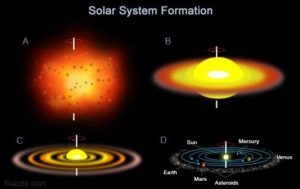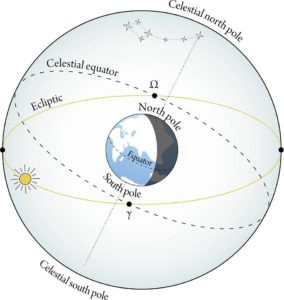Significance of Sun (The Big Bang & The Kaalachakra)
Sun is very important for life on earth. Though at odds with each other most of the times, both scientific and the spiritual communities have accepted and validated this in their own ways. After all, the seeking of the truth is central to both science and spirituality!!
The Big Bang


Sun is a main-sequence G2V star (spectral classification) at the center of our solar system. It powers life on earth. It gives us light and heat. Plants trap this light energy in their leaves for photosynthesis. The Sun powers the water cycle. The hydrological cycle maintains the ecosystem on earth while the heat exchange influences climate and generates weather patterns and seasons. How does Sun get so much energy to support life on earth?
Billions of years ago, there was a collision of a gigantic molecular cloud of gas (consisting of mainly hydrogen and helium) and dust known as the solar nebula. The nebula collapsed because of its gravity, spun faster and flattened into a disk. Most of the material in the center clumped, generated high temperatures (15 million degree C) and initiated a nuclear fusion at the core. Thus Sun was formed. Energy is produced at the core by nuclear fusion as Hydrogen converts to Helium. It takes millions of years for this energy to travel from the core of the Sun to its surface. But once at the surface it only takes 8 minutes and 25 seconds (dividing distance between earth & Sun by speed of light) for the solar rays to reach and power earth.
Kaalachakra – The Wheel of Time

Next, let us look at the concept of Time. Time is eternal with no beginning or end. The Sun plays a key role in dividing this eternal time into meaningful units such as day/night, month, year etc.
According to Vedas, Sun resides in Suryaloka (Sun-sphere) 1,00,000 yojanas (1yojana = 8miles) above the earth, right in between bhuloka (earth) and Bhuvarloka (Heavens). He constantly travels the sky in his massive chariot, ‘Saptashwa Ratham’. Sapta means seven and ashwa means horse. The seven horses yoked to this chariot represent the vasaras or seven days of the week. The chariot has only one wheel, the Kaalachakra. Varying units of Time on earth such as month, year, seasons etc. are established on this wheel known as Samvatsara. The axle of the wheel is tied to Dhruva, the pole star by a rope of wind. Dhruva is the Vedic equivalent of Polaris, the Northern pole star whose position is fixed in space. The Kaalachakra has twelve spokes. The spokes represent the twelve divisions of the sky (signs of the zodiac) and the six seasons are the sections of the rim. Time taken by this chariot to cross one division of the sky (one sign of the zodiac) is defined as one solar month on earth. Time taken to travel six divisions (one half of the sky) equals one Ayana, a six month period on earth. When the chariot travels six divisions south to north(Capricorn to Cancer) it is called Uttarayana. This six month period begins when Sun enters Capricorn (Makaram) around January 14th and ends when Sun leaves Cancer (Katakam) around July 16th. Uttara in Sanskrit means north and Ayana means movement. Uttarayana marks the end of winter solstice and arrival of longer days. Similarly, when the chariot travels six divisions north to south (Cancer to Capricorn) it is called Dakshinayana (Dakshina means south). It roughly corresponds to the second half of the year, July thru December. Also, as the chariot travels every two divisions in the sky a season passes on earth and hence seasonal changes are also part of this chakra. There are three seasons in one Ayana. Spring, Summer, and Monsoon are part of Uttarayana. Autumn, Fall, & Winter are a part of Dakshinayana. The aggregate of the two ayanas is one year or a Samvatsara. There are 60 Samvatsaras and once all 60 Samvatsaras are over the cycle repeats all over again. Various planets in our solar system are moving at varying speeds. For example, while it takes the Sun one month to cross one division of the sky it takes Jupiter one year to cover the same distance. Saturn takes 21/2 years. Taking into consideration all the planets, their speeds and relative positions at any given point in time it is only once in a cycle of 60 years the planets re-align in the same configuration in the sky as they were 60 years ago. This explains why the 60-year Samvatsara cycle aka ‘Shashti abdha poorthi’ is considered to be a significant milestone in one’s life. Riding in this chariot the Sun God travels the galaxy at a speed of 3,400,800 yojanas in a muhurtha. In other words, the orbital speed of Sun around the galaxy is a whopping 220km/second!!
I will conclude this week’s blog with a funny snippet. Incidentally, my son who is a namesake of Lord Surya also rides on ‘Saptashwa’ !!! Wait………..what??? Check out the picture.


Awesome!!!
Superb Radha